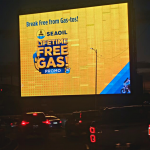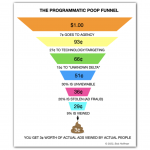For Programmatic OOH to succeed in SE Asia – Three things need to happen.
The current buzz word which is dominating the Out Of Home (OOH) media industry today seems to be programmatic, but I can’t help but feel we are still a long way from seeing any scale of programmatic trading on Digital OOH and probably never going to see it for traditional OOH, in South East Asia markets like Indonesia, Malaysia, Thailand, Philippines and Vietnam.
For programmatic to happen, there are three very real hurdles to overcome:
Standardisation
It’s a small word but the biggest issue and most immediate concern. OOH media information is still largely analogue a.k.a. slow and cumbersome. The task of digitising inventory details, location identifiers, mapping and other physical information, is the first step towards any automation in OOH media trading.
Both the physical information and attributes (such as audience and location profiles) need to be collated in a precise, common language so that everyone is comparing apples with apples.
The fact of the matter is that there are many in-house, subjective ways of listing and classifying OOH media. Even when automated platforms emerge, there is a tendency for multiple platforms to deliberately look and act differently, to emphasise self-interests.
In addition to agreeing on standards, it is important to have independent and objective controls in place to ensure accuracy, reliability and verification, across the industry.
There are published and reliable guidelines which could be adopted from overseas successes however, the process needs industry consultation within each market, involving every party that plays a role in the media marketplace, equally and impartially.
Once the standards are agreed, then the data gathering should take place with checks, to ensure standards are understood and applied.
Consolidation
Investment in data, systems, measurement and quality media assets, relies on some level of consolidation, as well creating scale to attract and support buying community interest.
Consolidation does not necessarily mean actual mergers of incorporated entities in OOH media ownership. Consolidation can happen at many levels.
Trading platforms themselves are a point of aggregation and consolidation. This task could (and perhaps should) be undertaken by the industry association, on behalf of all of the media owners, however not every market has an OOH or DOOH association and some are poorly resourced.
It begs the question, should the media owners shoulder the burden of collating the universe of data which is needed for programmatic to work. This is where the log-jam is happening right now. Media owners are reluctant to collaborate and contribute the cost to establish an industry-wide registry of site information.
Agencies are often struggling to make their in-house trading platforms geared to the OOH media segment, but many are making their own OOH registry and classification systems which is duplication of effort and wasted resources.
Third-party players are numerous and technology providers are all too keen to bundle up the OOH registry data of the industry but then they (rightly) will expect to monetise their services.
One way is to sell the services but media owners (and agencies) are reluctant to buy 3rd party tech services, unless the costs are relatively low and can be absorbed or recovered by incremental incomes.
The more common commercial model for 3rd party platforms is to apply commissions in the trading transactions. While this seems reasonable there are issues with price controls, commoditising the inventory and even unrealistic expectations of trading margins earned by the platform.
Ultimately the value of the registry in terms of efficiencies, better planning, easier buying, etc., has to be reflected in the price of the media and the margin it delivers to the media owner. There is too much pressure on price in the less mature markets in S.E. Asia, which is challenging ROI expectations, for whoever will invest in consolidated market place information.
In addition, it will take collective will and sizeable investment for the industry to establish uniform “currency” of audience data. OOH media and especially DOOH can be measured in similar ways to online and mobile with granular details of audiences, places and even store visits and purchases. DOOH is able to be traded on a cost per impression basis but in reality this too is a long way from happening.
The cost is significant if we are going to generate deep data by audiences, locations, activities and even actual time of day.
Markets where OOH is thriving and where this type of data exists, primed for programmatic, are typically centralised in their approach to the industry data and investment in measurement, often via a strong and well-funded outdoor association.
Education (facts not fiction)
This is a broad issue and is about learning and sharing. Technologies can generate deep and detailed data about audiences for OOH media and attribution and complex understanding of dynamics to deliver relevant and targeted (and contextual) advertising to consumers.
The task is to analyse the data and to learn the key factors, appropriate to selected assets or selected brands or selected localities. We then need to share insights with the media buying community.
The ‘sales’ effort of the media owners will need to shift to education. Current selling practices have to change, to start dialogue with planners and buyers about solutions, backed up with solid reasoning, justification, accountability and the anticipated resulting effect of the media investment (ROI).
At the point in time, when we have standards across media assets and measurement, on scale, we will need to share this information with the media buying community so they have the facts and a total view of the media options. This will lift the confidence in OOH media buying and elevate trust and belief in the value of OOH. This is when we will see OOH share of Adspend grow.
When these three challenges have been addressed, it will then be a natural extension to see automation in OOH and DOOH trading, with some portion of spend being traded programmatically.
When it happens, there will be better understanding of the value of OOH, much less pressure on price and a balanced approach supported by every level in the OOH media ecosystem.
Once the inventory and all of the assigned data points have been collated, it is right that the information is shared as widely as possible. It is not likely, that one or a few platforms will control the information and dominate trading.
In thriving markets, media agencies share the largest proportion of OOH media trading, with several supply-side platforms each filling a role plus some programmatic desks. There is no single point of control and there is balance, with each trading channel adding value in some way.
Ron Graham
Ron is an industry veteran and independent consultant for out of home media in Asia Pacific region
MARKETING Magazine is not responsible for the content of external sites.
After 20 years of evolving technology, shifting market trends, and adapting to changing consumer behaviour, the media landscape has nearly reached saturation.
We’ve optimised to the fullest, providing advertisers with abundant choices across technology, platforms, data-driven marketing, CTV, OTT, DOOH, influencer marketing, retail, etc.
Media specialists have diversified, but with more options comes the challenge of maintaining income growth. The industry is expanding, but revenue isn’t keeping pace.
Now, we’re at a TURNING POINT: time to explore and harness new sustainable revenue streams. While GroupM forecasts a 7.8% global ad revenue growth in 2024, challenges like antitrust regulation, AI and copyright issues, and platform bans persist.
Collaboration is key: partnerships that thrive on synergy, shared values, and aligned goals are becoming increasingly essential.
Hence, the Malaysian Media Conference, in its 20th year, has assembled the partners and players under one roof on October 25 for a day of learning, sharing, and exploring.
REGISTER NOW











